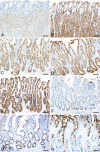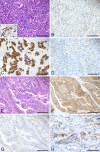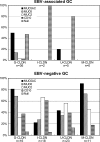Epstein-Barr virus-associated gastric carcinoma: a distinct carcinoma of gastric phenotype by claudin expression profiling
- PMID: 19398608
- PMCID: PMC2713077
- DOI: 10.1369/jhc.2009.953810
Epstein-Barr virus-associated gastric carcinoma: a distinct carcinoma of gastric phenotype by claudin expression profiling
Abstract
Epstein-Barr virus (EBV)-associated gastric carcinoma (GC) is a distinct subtype with characteristic clinicopathological features. To better characterize its cellular characteristics, 43 cases of EBV-associated GC, 68 cases of EBV-negative GC, and non-neoplastic gastric mucosa in adults and fetuses were examined immunohistochemically. We quantified the expression of the major tight-junction protein claudin (CLDN) -1, -3, -4, -7, and -18 together with gastric mucins (MUC5AC and MUC6), intestinal mucin (MUC2), and CD10. EBV-associated GC showed a high frequency of CLDN18 expression (84%) and a low frequency of CLDN3 expression (5%). This expression profile corresponded to that of normal gastric epithelium in adults and fetuses. Almost half of the EBV-associated GC cases demonstrated gastric mucin expression, whereas the other half lacked mucin or CD10 expression. In contrast, as demonstrated by the expression profiles of CLDN3 and CLDN18, EBV-negative GC comprised a heterogeneous group of four different CLDN phenotypes: gastric, intestinal, mixed, and an undifferentiated type with variable expression patterns of mucins. These results indicate that EBV-associated GC is considerably homogenous with regard to cellular differentiation and that it preserves well the nature of the cells of origin. EBV-associated GC may undergo distinct carcinogenic processes, which differ from those of EBV-negative GC.
Figures






References
-
- Barua RR, Uozaki H, Chong JM, Ushiku T, Hino R, Chang MS, Nagai H, et al. (2006) Phenotype analysis by MUC2, MUC5AC, MUC6, and CD10 expression in Epstein-Barr virus-associated gastric carcinoma. J Gastroenterol 41:733–739 - PubMed
-
- Chang MS, Uozaki H, Chong JM, Ushiku T, Sakuma K, Ishikawa S, Hino R, et al. (2006) CpG island methylation status in gastric carcinoma with and without infection of Epstein-Barr virus. Clin Cancer Res 12:2995–3002 - PubMed
-
- Fukayama M, Hayashi Y, Iwasaki Y, Chong J, Ooba T, Takizawa T, Koike M, et al. (1994) Epstein-Barr virus-associated gastric carcinoma and Epstein-Barr virus infection of the stomach. Lab Invest 71:73–81 - PubMed
Publication types
MeSH terms
Substances
LinkOut - more resources
Full Text Sources
Other Literature Sources
Medical
Miscellaneous

